

This article needs additional citations for verification. Please help improve this articlebyadding citations to reliable sources. Unsourced material may be challenged and removed.
Find sources: "History of technology" – news · newspapers · books · scholar · JSTOR (April 2015) (Learn how and when to remove this message) |
For an account of the contemporary use of production techniques, see Technology. For other uses, see Technology (disambiguation).
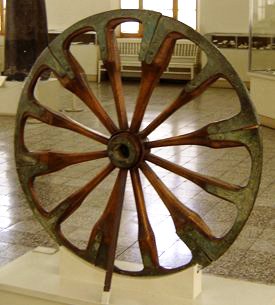
The history of technology is the history of the inventionoftools and techniques and is similar to other sides of the history of humanity. Technology can refer to methods ranging from as simple as language and stone tools to the complex genetic engineering and information technology that has emerged since the 1980s.
New knowledge has enabled people to create new things, and conversely, many scientific endeavors are made possible by technologies which assist humans in travelling to places they could not previously reach, and by scientific instruments by which we study nature in more detail than our natural senses allow.
Since much of technology is applied science, technical history is connected to the history of science. Since technology uses resources, technical history is tightly connected to economic history. From those resources, technology produces other resources, including technological artifacts used in everyday life.
Technological change affects, and is affected by, a society's cultural traditions. It is a force for economic growth and a means to develop and project economic, political and military power.
Many sociologists and anthropologists have created social theories dealing with social and cultural evolution. Some, like Lewis H. Morgan, Leslie White, and Gerhard Lenski, have declared technological progress to be the primary factor driving the development of human civilization. Morgan's concept of three major stages of social evolution (savagery, barbarism, and civilization) can be divided by technological milestones, such as fire. White argued the measure by which to judge the evolution of culture was energy.[1]
For White, "the primary function of culture" is to "harness and control energy." White differentiates between five stages of human development: In the first, people use energy of their own muscles. In the second, they use energy of domesticated animals. In the third, they use the energy of plants (agricultural revolution). In the fourth, they learn to use the energy of natural resources: coal, oil, gas. In the fifth, they harness nuclear energy. White introduced a formula P=E*T, where E is a measure of energy consumed, and T is the measure of efficiency of technical factors utilizing the energy. In his own words, "culture evolves as the amount of energy harnessed per capita per year is increased, or as the efficiency of the instrumental means of putting the energy to work is increased". Russian astronomer Nikolai Kardashev extrapolated his theory, creating the Kardashev scale, which categorizes the energy use of advanced civilizations.
Lenski's approach focuses on information. The more information and knowledge (especially allowing the shaping of natural environment) a given society has, the more advanced it is. He identifies four stages of human development, based on advances in the history of communication. In the first stage, information is passed by genes. In the second, when humans gain sentience, they can learn and pass information through by experience. In the third, the humans start using signs and develop logic. In the fourth, they can create symbols, develop language and writing. Advancements in communications technology translates into advancements in the economic system and political system, distribution of wealth, social inequality and other spheres of social life. He also differentiates societies based on their level of technology, communication and economy:
In economics productivity is a measure of technological progress. Productivity increases when fewer inputs (labor, energy, materials or land) are used in the production of a unit of output.[2] Another indicator of technological progress is the development of new products and services, which is necessary to offset unemployment that would otherwise result as labor inputs are reduced. In developed countries productivity growth has been slowing since the late 1970s; however, productivity growth was higher in some economic sectors, such as manufacturing.[3] For example, in employment in manufacturing in the United States declined from over 30% in the 1940s to just over 10% 70 years later. Similar changes occurred in other developed countries. This stage is referred to as post-industrial.
In the late 1970s sociologists and anthropologists like Alvin Toffler (author of Future Shock), Daniel Bell and John Naisbitt have approached the theories of post-industrial societies, arguing that the current era of industrial society is coming to an end, and services and information are becoming more important than industry and goods. Some extreme visions of the post-industrial society, especially in fiction, are strikingly similar to the visions of near and post-Singularity societies.

The following is a summary of the history of technology by time period and geography:

During most of the Paleolithic - the bulk of the Stone Age - all humans had a lifestyle which involved limited tools and few permanent settlements. The first major technologies were tied to survival, hunting, and food preparation. Stone tools and weapons, fire, and clothing were technological developments of major importance during this period.
Human ancestors have been using stone and other tools since long before the emergence of Homo sapiens approximately 200,000 years ago.[4] The earliest methods of stone tool making, known as the Oldowan "industry", date back to at least 2.3 million years ago,[5] with the earliest direct evidence of tool usage found in Ethiopia within the Great Rift Valley, dating back to 2.5 million years ago.[6] This era of stone tool use is called the Paleolithic, or "Old stone age", and spans all of human history up to the development of agriculture approximately 12,000 years ago.
To make a stone tool, a "core" of hard stone with specific flaking properties (such as flint) was struck with a hammerstone. This flaking produced sharp edges which could be used as tools, primarily in the form of choppersorscrapers.[7] These tools greatly aided the early humans in their hunter-gatherer lifestyle to perform a variety of tasks including butchering carcasses (and breaking bones to get at the marrow); chopping wood; cracking open nuts; skinning an animal for its hide; and even forming other tools out of softer materials such as bone and wood.[8]
The earliest stone tools were crude, being little more than a fractured rock. In the Acheulian era, beginning approximately 1.65 million years ago, methods of working these stone into specific shapes, such as hand axes emerged. This early Stone Age is described as EpipaleolithicorMesolithic. The former is generally used to describe the early Stone Age in areas with limited glacial impact.
The Middle Paleolithic, approximately 300,000 years ago, saw the introduction of the prepared-core technique, where multiple blades could be rapidly formed from a single core stone.[7] The Upper Paleolithic, beginning approximately 40,000 years ago, saw the introduction of pressure flaking, where a wood, bone, or antler punch could be used to shape a stone very finely.[9]
The later Stone Age, during which the rudiments of agricultural technology were developed, is called the Neolithic period. During this period, polished stone tools were made from a variety of hard rocks such as flint, jade, jadeite and greenstone, largely by working exposures as quarries, but later the valuable rocks were pursued by tunnelling underground, the first steps in mining technology. The polished axes were used for forest clearance and the establishment of crop farming, and were so effective as to remain in use when bronze and iron appeared.
Stone Age cultures developed music, and engaged in organized warfare. Stone Age humans developed ocean-worthy outrigger canoe technology, leading to migration across the Malay archipelago, across the Indian Ocean to Madagascar and also across the Pacific Ocean, which required knowledge of the ocean currents, weather patterns, sailing, and celestial navigation.
Although Paleolithic cultures left no written records, the shift from nomadic life to settlement and agriculture can be inferred from a range of archaeological evidence. Such evidence includes ancient tools,[10] cave paintings, and other prehistoric art, such as the Venus of Willendorf. Human remains also provide direct evidence, both through the examination of bones, and the study of mummies. Scientists and historians have been able to form significant inferences about the lifestyle and culture of various prehistoric peoples, and especially their technology.
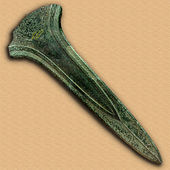
The Stone Age developed into the Bronze Age after the Neolithic Revolution. The Neolithic Revolution involved radical changes in agricultural technology which included development of agriculture, animal domestication, and the adoption of permanent settlements. These combined factors made possible the development of metal smelting, with copper and later bronze, an alloy of tin and copper, being the materials of choice, although polished stone tools continued to be used for a considerable time owing to their abundance compared with the less common metals (especially tin).
This technological trend apparently began in the Fertile Crescent, and spread outward over time. These developments were not, and still are not, universal. The three-age system does not accurately describe the technology history of groups outside of Eurasia, and does not apply at all in the case of some isolated populations, such as the Spinifex People, the Sentinelese, and various Amazonian tribes, which still make use of Stone Age technology, and have not developed agricultural or metal technology.

The Iron Age involved the adoption of iron smelting technology. It generally replaced bronze, and made it possible to produce tools which were stronger, lighter and cheaper to make than bronze equivalents. In many Eurasian cultures, the Iron Age was the last major step before the development of written language, though again this was not universally the case. It was not possible to mass manufacture steel because high furnace temperatures were needed, but steel could be produced by forging bloomery iron to reduce the carbon content in a controllable way. Iron ores were much more widespread than either copper or tin. In Europe, large hill forts were built either as a refuge in time of war, or sometimes as permanent settlements. In some cases, existing forts from the Bronze Age were expanded and enlarged. The pace of land clearance using the more effective iron axes increased, providing more farmland to support the growing population.
It was the growth of the ancient civilizations which produced the greatest advances in technology and engineering, advances which stimulated other societies to adopt new ways of living and governance.
The Egyptians invented and used many simple machines, such as the ramp to aid construction processes. The Indus Valley Civilization, situated in a resource-rich area, is notable for its early application of city planning and sanitation technologies. Ancient India was also at the forefront of seafaring technology—a panel found at Mohenjodaro depicts a sailing craft. Indian construction and architecture, called 'Vaastu Shastra', suggests a thorough understanding of materials engineering, hydrology, and sanitation.
The peoples of Mesopotamia (Sumerians, Assyrians, and Babylonians) have been credited with the invention of the wheel, but this is no longer certain. They lived in cities from c. 4000 BC,[11] and developed a sophisticated architecture in mud-brick and stone,[12] including the use of the true arch. The walls of Babylon were so massive they were quoted as a Wonder of the World. They developed extensive water systems; canals for transport and irrigation in the alluvial south, and catchment systems stretching for tens of kilometres in the hilly north. Their palaces had sophisticated drainage systems.[13]
Writing was invented in Mesopotamia, using cuneiform script. Many records on clay tablets and stone inscriptions have survived. These civilizations were early adopters of bronze technologies which they used for tools, weapons and monumental statuary. By 1200 BC they could cast objects 5 m long in a single piece. The Assyrian King Sennacherib (704-681 BC) claims to have invented automatic sluices and to have been the first to use water screws, of up to 30 tons weight, which were cast using two-part clay moulds rather than by the 'lost wax' process.[13] The Jerwan Aqueduct (c. 688 BC) is made with stone arches and lined with waterproof concrete.[14]
The Babylonian astronomical diaries spanned 800 years. They enabled meticulous astronomers to plot the motions of the planets and to predict eclipses.[15]
The Chinese made many first-known discoveries and developments. Major technological contributions from China include early seismological detectors, matches, paper, sliding calipers, the double-action piston pump, cast iron, the iron plough, the multi-tube seed drill, the wheelbarrow, the suspension bridge, the parachute, natural gas as fuel, the compass, the raised-relief map, the propeller, the crossbow, the South Pointing Chariot and gunpowder.
Other Chinese discoveries and inventions from the Medieval period,include: block printing, movable type printing, phosphorescent paint, endless power chain drive and the clock escapement mechanism.The solid-fuel rocket was invented in China about 1150, nearly 200 years after the invention of gunpowder (which acted as the rocket's fuel). Decades before the West's age of exploration, the Chinese emperors of the Ming Dynasty also sent large fleets for maritime voyages, some reaching Africa.

Greek and Hellenistic engineers were responsible for myriad inventions and improvements to existing technology. The Hellenistic period in particular saw a sharp increase in technological advancement, fostered by a climate of openness to new ideas, the blossoming of a mechanistic philosophy, and the establishment of the Library of Alexandria and its close association with the adjacent museion. In contrast to the typically anonymous inventors of earlier ages, ingenious minds such as Archimedes, Philo of Byzantium, Heron, Ctesibius, and Archytas remain known by name to posterity.
Ancient Greek innovations were particularly pronounced in mechanical technology, including the ground-breaking invention of the watermill which constituted the first human-devised motive force not to rely on muscle power (besides the sail). Apart from their pioneering use of waterpower, Greek inventors were also the first to experiment with wind power (see Heron's windwheel) and even created the earliest steam engine (the aeolipile), opening up entirely new possibilities in harnessing natural forces whose full potential would not be exploited until the Industrial Revolution. The newly devised right-angled gear and screw would become particularly important to the operation of mechanical devices.
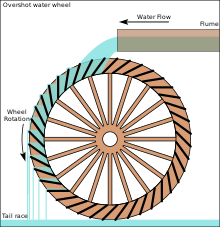
Ancient agriculture, as in any period prior to the modern age the primary mode of production and subsistence, and its irrigation methods, were considerably advanced by the invention and widespread application of a number of previously unknown water-lifting devices, such as the vertical water-wheel, the compartmented wheel, the water turbine, Archimedes' screw, the bucket-chain and pot-garland, the force pump, the suction pump, the double-action piston pump and quite possibly the chain pump.[16]
In music, the water organ, invented by Ctesibius and subsequently improved, constituted the earliest instance of a keyboard instrument. In time-keeping, the introduction of the inflow clepsydra and its mechanization by the dial and pointer, the application of a feedback system and the escapement mechanism far superseded the earlier outflow clepsydra.
The famous Antikythera mechanism, a kind of analogous computer working with a differential gear, and the astrolabe both show great refinement in astronomical science.
Greek engineers were also the first to devise automata such as vending machines, suspended ink pots, automatic washstands and doors, primarily as toys, which however featured many new useful mechanisms such as the cam and gimbals.
In other fields, ancient Greek inventions include the catapult and the gastraphetes crossbow in warfare, hollow bronze-casting in metallurgy, the dioptra for surveying, in infrastructure the lighthouse, central heating, the tunnel excavated from both ends by scientific calculations, the ship trackway, the dry dock and plumbing. In horizontal vertical and transport great progress resulted from the invention of the crane, the winch, the wheelbarrow and the odometer.
Further newly created techniques and items were spiral staircases, the chain drive, sliding calipers and showers.
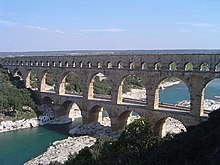
The Romans developed an intensive and sophisticated agriculture, expanded upon existing iron working technology, created laws providing for individual ownership, advanced stone masonry technology, advanced road-building (exceeded only in the 19th century), military engineering, civil engineering, spinning and weaving and several different machines like the Gallic reaper that helped to increase productivity in many sectors of the Roman economy. Roman engineers were the first to build monumental arches, amphitheatres, aqueducts, public baths, true arch bridges, harbours, reservoirs and dams, vaults and domes on a very large scale across their Empire. Notable Roman inventions include the book (Codex), glass blowing and concrete. Because Rome was located on a volcanic peninsula, with sand which contained suitable crystalline grains, the concrete which the Romans formulated was especially durable. Some of their buildings have lasted 2000 years, to the present day.
The engineering skills of the Inca and the Mayans were great, even by today's standards. An example is the use of pieces weighing upwards of one ton in their stonework placed together so that not even a blade can fit in-between the cracks. The villages used irrigation canals and drainage systems, making agriculture very efficient. While some claim that the Incas were the first inventors of hydroponics, their agricultural technology was still soil based, if advanced. Though the Maya civilization had no metallurgy or wheel technology, they developed complex writing and astrological systems, and created sculptural works in stone and flint. Like the Inca, the Maya also had command of fairly advanced agricultural and construction technology. Throughout this time period, much of this construction was made only by women, as men of the Maya civilization believed that females were responsible for the creation of new things. The main contribution of the Aztec rule was a system of communications between the conquered cities. In Mesoamerica, without draft animals for transport (nor, as a result, wheeled vehicles), the roads were designed for travel on foot, just like the Inca and Mayan civilizations
As earlier empires had done, the Muslim caliphates united in trade large areas that had previously traded little. The conquered sometimes paid lower taxes than in their earlier independence, and ideas spread even more easily than goods. Peace was more frequent than it had been. These conditions fostered improvements in agriculture and other technology as well as in sciences which largely adapted from earlier Greek, Roman and Persian empires, with improvements.
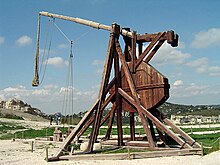
European technology in the Middle Ages may be best described as a symbiosis of traditio et innovatio. While medieval technology has been long depicted as a step backwards in the evolution of Western technology, sometimes willfully so by modern authors intent on denouncing the church as antagonistic to scientific progress (see e.g. Myth of the Flat Earth), a generation of medievalists around the American historian of science Lynn White stressed from the 1940s onwards the innovative character of many medieval techniques. Genuine medieval contributions include for example mechanical clocks, spectacles and vertical windmills. Medieval ingenuity was also displayed in the invention of seemingly inconspicuous items like the watermark or the functional button. In navigation, the foundation to the subsequent age of exploration was laid by the introduction of pintle-and-gudgeon rudders, lateen sails, the dry compass, the horseshoe and the astrolabe.
Significant advances were also made in military technology with the development of plate armour, steel crossbows, counterweight trebuchets and cannon. The Middle Ages are perhaps best known for their architectural heritage: While the invention of the rib vault and pointed arch gave rise to the high rising Gothic style, the ubiquitous medieval fortifications gave the era the almost proverbial title of the 'age of castles'.
Papermaking, a 2nd-century Chinese technology, was carried to the Middle East when a group of Chinese papermakers were captured in the 8th century.[17] Papermaking technology was spread to Europe by the Umayyad conquest of Hispania.[18] A paper mill was established in Sicily in the 12th century. In Europe the fiber to make pulp for making paper was obtained from linen and cotton rags. Lynn White credited the spinning wheel with increasing the supply of rags, which led to cheap paper, which was a factor in the development of printing.[19]
|
The era is marked by such profound technical advancements like linear perceptivity, double shell domesorBastion fortresses. Note books of the Renaissance artist-engineers such as Taccola and Leonardo da Vinci give a deep insight into the mechanical technology then known and applied. Architects and engineers were inspired by the structures of Ancient Rome, and men like Brunelleschi created the large dome of Florence Cathedral as a result. He was awarded one of the first patents ever issued in order to protect an ingenious crane he designed to raise the large masonry stones to the top of the structure. Military technology developed rapidly with the widespread use of the cross-bow and ever more powerful artillery, as the city-states of Italy were usually in conflict with one another. Powerful families like the Medici were strong patrons of the arts and sciences. Renaissance science spawned the Scientific Revolution; science and technology began a cycle of mutual advancement.
The invention of the movable cast metal type printing press, whose pressing mechanism was adapted from an olive screw press, (c. 1441) lead to a tremendous increase in the number of books and the number of titles published.
An improved sailing ship, the (nau or carrack), enabled the Age of Exploration with the European colonization of the Americas, epitomized by Francis Bacon's New Atlantis. Pioneers like Vasco da Gama, Cabral, Magellan and Christopher Columbus explored the world in search of new trade routes for their goods and contacts with Africa, India and China to shorten the journey compared with traditional routes overland. They produced new maps and charts which enabled following mariners to explore further with greater confidence. Navigation was generally difficult, however, owing to the problem of longitude and the absence of accurate chronometers. European powers rediscovered the idea of the civil code, lost since the time of the Ancient Greeks.
|
The British Industrial Revolution is characterized by developments in the areas of textile manufacturing, mining, metallurgy and transport driven by the development of the steam engine. Above all else, the revolution was driven by cheap energy in the form of coal, produced in ever-increasing amounts from the abundant resources of Britain. Coal converted to coke gave the blast furnace and cast iron in much larger amounts than before, and a range of structures could be created, such as The Iron Bridge. Cheap coal meant that industry was no longer constrained by water resources driving the mills, although it continued as a valuable source of power. The steam engine helped drain the mines, so more coal reserves could be accessed, and the output of coal increased. The development of the high-pressure steam engine made locomotives possible, and a transport revolution followed.[20]

The 19th century saw astonishing developments in transportation, construction, manufacturing and communication technologies originating in Europe. The steam engine which had existed since the early 18th century, was practically applied to both steamboat and railway transportation. The Liverpool and Manchester Railway, the first purpose built railway line, opened in 1830, the Rocket locomotiveofRobert Stephenson being one of its first working locomotives used. Telegraphy also developed into a practical technology in the 19th century to help run the railways safely.
Other technologies were explored for the first time, including the incandescent light bulb. The invention of the incandescent light bulb had a profound effect on the workplace because factories could now have second and third shift workers. Manufacture of ships' pulley blocks by all-metal machines at the Portsmouth Block Mills instigated the age of mass production. Machine tools used by engineers to manufacture parts began in the first decade of the century, notably by Richard Roberts and Joseph Whitworth. The development of interchangeable parts through what is now called the American system of manufacturing began in the firearms industry at the U.S Federal arsenals in the early 19th century, and became widely used by the end of the century.
Shoe production was mechanized and sewing machines introduced around the middle of the 19th century. Mass production of sewing machines and agricultural machinery such as reapers occurred in the mid to late 19th century. Bicycles were mass-produced beginning in the 1880s.
Steam-powered factories became widespread, although the conversion from water power to steam occurred in England before in the U.S.
Steamships were eventually completely iron-clad, and played a role in the opening of Japan and China to trade with the West. The Second Industrial Revolution at the end of the 19th century saw rapid development of chemical, electrical, petroleum, and steel technologies connected with highly structured technology research.
The period from the last third of the 19th century until WW1 is sometimes referred to as the Second Industrial Revolution.

20th century technology developed rapidly. Broad teaching and implementation of the scientific method, and increased research spending contributed to the advancement of modern science and technology. New technology improved communication and transport, thus spreading technical understanding. Mass production brought automobiles and other high-tech goods to masses of consumers. Military research and development sped advances including electronic computing and jet engines. Radio and telephony improved greatly and spread to larger populations of users, though near-universal access would not be possible until mobile phones became affordable to developing world residents in the late 2000s and early 2010s.
Genetic engineering saw enormous advances in the last quarter of the 20th century. Electron microscopes were very powerful by the late 1970s and genetic theory and knowledge were expanding exponentially.
The first "test tube baby" Louise Brown was born in 1978, which led to the first successful gestational surrogate pregnancy in 1985 and the first pregnancy by ICSI in 1991, which is the implanting of a single sperm into an egg. Preimplantation genetic diagnosis was first performed in late 1989 and led to successful births in July 1990. These procedures have become relatively common and are changing the concept of what it means to be a parent.
Electrification spread rapidly in the 20th century. At the beginning of the century electric power was for the most part only available to wealthy people in a few major cities such as New York, London, Paris, and Newcastle upon Tyne, but by the time the World Wide Web was invented in 1990 an estimated 62 percent of homes worldwide had electric power, including about a third of households in [21] the rural developing world.
Energy and engine technology improvements included nuclear power, developed after the Manhattan project. Rocket development led to long range missiles and the first space age that lasted from the 1950s to the mid-1980s.
Vaccination spread rapidly to the developing world from the 1980s onward due to many successful humanitarian initiatives, greatly reducing childhood mortality in many poor countries with limited medical resources.
The US National Academy of Engineering, by expert vote, established the following ranking of the most important technological developments of the 20th century:[22]

In the early 21st century, the main technology being developed is electronics. Broadband Internet access became commonplace in developed countries, as did wireless Internet on smartphones that are capable of multimedia playback (video, audio, and eBooks) and running other applications (e.g., navigation, productivity tools, and games). The price of 3D printers is steadily decreasing and finding uses in many areas.
Research is ongoing into quantum computers, nanotechnology, bioengineering/biotechnology, nuclear technology, advanced materials (e.g., graphene), the scramjet and drones (along with railguns and high-energy laser beams for military uses), superconductivity, the memristor, and green technologies such as alternative fuels (e.g., fuel cells, self-driving electric & plug-in hybrid cars), augmented reality devices and wearable electronics, artificial intelligence, and more efficient & powerful LEDs, solar cells, integrated circuits, wireless power devices, engines, and batteries.
The understanding of particle physics is also expected to expand with better instruments including larger particle accelerators [23] and better neutrino detectors. Dark matter is sought via underground detectors and LIGO is trying to detect gravitational waves.
New spaceflight technology and spacecraft are also being developed, like the Orion and Dragon. New, more capable space telescopes are being designed. The International Space Station was completed in the 2000s, and NASA and ESA plan a manned mission to Mars in the 2030s. The Variable Specific Impulse Magnetoplasma Rocket (VASIMR) is an electro-magnetic thruster for spacecraft propulsion and is expected to be tested in 2015.
This section is in list format but may read better as prose. You can help by converting this section, if appropriate. Editing help is available. (March 2015)
|
This "see also" section may contain an excessive number of entries. Please ensure that only the most relevant links are given, that they are not red links, and that any links are not already in this article. (April 2015) (Learn how and when to remove this message)
|
{{cite journal}}: Cite journal requires |journal= (help)
{{cite book}}: CS1 maint: location missing publisher (link) CS1 maint: postscript (link)
{{cite journal}}: Cite journal requires |journal= (help)
|
| |
|---|---|
| Lists of inventions or discoveries by country/region |
|
| by topic |
|
| Lists of inventors or discoverers by country/region |
|
|
Technology and related concepts
| |||||||||||||||||||||||||||||||||
|---|---|---|---|---|---|---|---|---|---|---|---|---|---|---|---|---|---|---|---|---|---|---|---|---|---|---|---|---|---|---|---|---|---|
| |||||||||||||||||||||||||||||||||
| |||||||||||||||||||||||||||||||||
| |||||||||||||||||||||||||||||||||
|
| |||||||||||||||||||||||||||||||||
|
| |
|---|---|
| Economics |
|
| History |
|
| Philosophy |
|
| Sociology |
|
| Science studies |
|
| Technology studies |
|
| Policy |
|
| |
| National |
|
|---|---|
| Other |
|